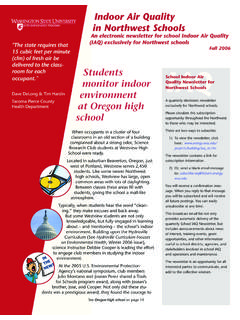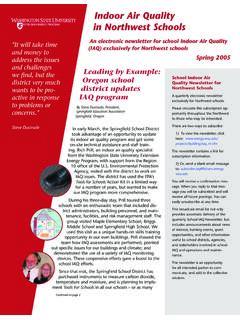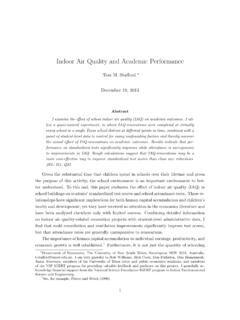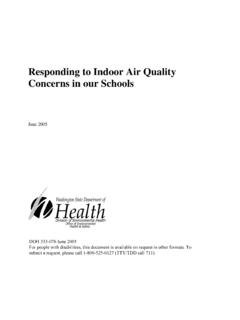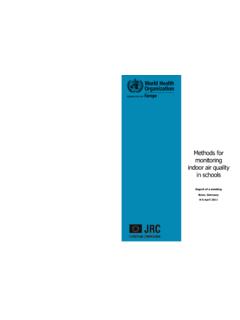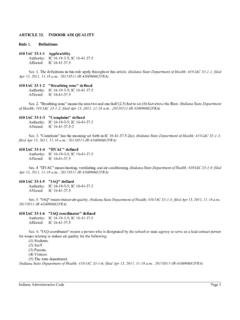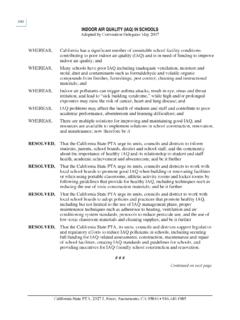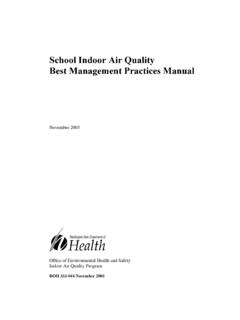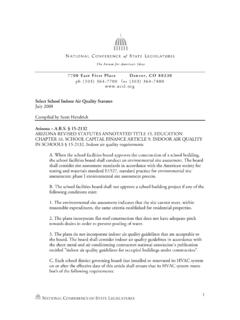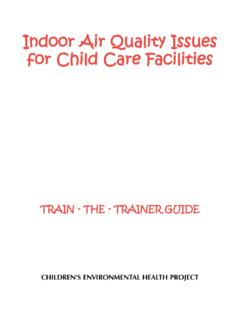Transcription of EPA Indoor Air Quality Tools for SchoolsAction Kit ...
1 Indoor Air Quality (IAQ) Indoor Air Quality Tools for Schools REFERENCE GUIDEI ndoor Air Quality Tools for Schools REFERENCE 18/31/08 2:35:48 Environmental Protection AgencyIndoor Environments Division, 6609J1200 Pennsylvania Avenue, NWWashington, DC 20460(202) Federation of Teachers555 New Jersey Avenue, NWWashington, DC 20001(202) of school Business Officials11401 North Shore DriveReston, VA 22090(703) Education Association1201 16th Steet, NWWashington, DC 20036-3290(202) Parent Teachers Association330 North Wabash Avenue, Suite 2100 Chicago, IL 60611-3690(312) Lung Association1740 BroadwayNew York, NY 10019(212) 402/K-07/008 I January 2009 I 28/31/08 2:35:49 PMUnderstanding the importance of goodindoor air Quality (IAQ) in schools is thebackbone of developing an effective IAQprogram. Poor IAQ can lead to a largevariety of health problems and potentiallyaffect comfort, concentration, and staff/student performance. In recognition oftight school budgets, this guidance isdesigned to present practical and oftenlow-cost actions you can take to identifyand address existing or potential airquality problems.
2 You can accomplish thisusing current school staff to perform alimited and well-defined set of basicoperations and maintenance , some actions may requirespecialized 1 and 2 of this Guide helpschools understand how IAQ problemsdevelop, the importance of good IAQ, andits impact on students, staff, and buildingoccupants. Communicating this importantinformation with students, staff, parents,and the community is the next step, whichis outlined in Section 3. Schools dealingwith an IAQ crisis will find the section oncommunication particularly 4 to 6 contain valuableinformation for schools that needassistance diagnosing and responding toIAQ problems withinexpensive, practical to the appendices of this Guide fordetailed information on IAQ-related topicsincluding mold, radon, secondhandsmoke, asthma, and portable may find the explanations ofintegrated pest management programs,typical Indoor air pollutants, andpollutants from motor vehicles andequipment helpful while developingschool policies or pinpointing sources ofpoor IAQ.
3 In addition, schoolsIntroductioninvestigating or resolving IAQ problemsmay want to refer to appendices on basicmeasurement equipment, hiringprofessional assistance, and codes andregulations. There are numerous resourcesavailable to schools through EPA andother organizations, many of which arelisted in Appendix L. Use the informationin this Guide to create the best possiblelearning environment for students andmaintain a comfortable, healthy buildingfor school common-sense guidance isdesigned to helpyou prevent andsolve themajority of indoorair problems withminimal cost EPA D , 3:54 PM1ii80897 EPA D , 3:54 PM2 ContentsIntroductioniAcknowledgmentsvBAS ICSS ection 1 Why IAQ Is Important to Your School1 Why IAQ Is Important1 Unique Aspects of Schools2 Section 2 Understanding IAQ Problems3 Sources of Indoor Air Pollutants3 Interaction of Sources, HVAC Systems,Pathways, and Occupants3 HVAC System Design and Operation4 Description of HVAC Systems5 Thermal Comfort5 Ventilation For Occupant Needs6 Pollutant Pathways and Driving Forces6 Building Occupants7 Section 3 Effective Communication9 Proactive Communication9 Responsive Communication10 Communication Principles11 Section 4 Resolving IAQ Problems13Is This an Emergency?
4 13 Who Will Solve the Problem?14 Section 5 Diagnosing IAQ Problems15 How to Diagnose Problems15 Spatial and Timing Patterns15 Section 6 Solving IAQ Problems17 Developing Solutions17 Solutions for Other Complaints18 Evaluating Solutions18 Evaluating the Effectiveness of Your Solution19 Persistent Problems20iiiNote: Separatepieces in this Kitinclude: IAQ Coordinator sGuide; IAQ Road Map; IAQ Backgrounder; IAQ Checklists; Fact Sheet onDistrict-wideImplementation; Awards Program; Managing Asthmain the SchoolEnvironment; Two Videos; and IAQ ProblemSolving EPA D , 3:54 PM3 APPENDICESA ppendix AHiring Professional Assistance21 Appendix BBasic Measurement Equipment25 Appendix CCodes and Regulations27 Appendix DAsthma29 Appendix ETypical Indoor Air Pollutants33 Appendix FSecondhand Smoke39 Appendix GRadon43 Appendix HMold and Moisture45 Appendix IEmissions from Motor Vehicles and Equipment49 Appendix JPortable Classrooms53 Appendix KIntegrated Pest Management57 Appendix LResources59 Appendix MGlossary and Acronyms79 INDEX85iv80897 EPA D , 3:54 PM4 DISCLAIMERAny information gathered using this Kit isfor the benefit and use of schools andschool districts.
5 EPA does not requireretention or submission of anyinformation gathered, and EPA has noregulatory or enforcement authorityregarding general Indoor air Quality inschools. This Kit has been reviewed inaccordance with EPA s provides the current scientificand technical understanding of the issuespresented. Following the advice given willnot necessarily provide completeprotection in all situations or against allhealth hazards that may be caused byindoor air of any trade names orcommercial products does not constituteendorsement or recommendation for note the following as you prepareto use this Kit: This Kit is not intended as a substitutefor appropriate emergency action in ahazardous situation that may beimmediately threatening to life orsafety. Modification of building functions,equipment, or structure to remedy airquality complaints may create otherindoor air Quality problems and mayimpact life-safety systems and energyuse. A thorough understanding of allthe factors that interact to create indoorair Quality problems can help avoid thisundesirable outcome.
6 Consult withprofessionals as necessary. In the event that medical records areused while evaluating an IAQ problem,maintain Kit contains public information thatmay be reproduced or modified in wholeor in part without permission. If it isreproduced or modified, EPA wouldappreciate knowing how it is used. Pleasewrite:IAQ Tools for SchoolsIndoor Environments Division, # Environmental Protection Agency1200 Pennsylvania Avenue, NWWashington, DC 20460 For more information, see EPA s Web EPA D , 3:54 PM511 Most people are aware that outdoor airpollution can impact their health, butindoor air pollution can also havesignificant and harmful health effects. Environmental Protection Agency(EPA) studies of human exposure to airpollutants indicate that Indoor levels ofpollutants may be two to five times andoccasionally more than 100 times higherthan outdoor levels. These levels of indoorair pollutants are of particular concernbecause most people spend about 90percent of their time indoors.
7 For thepurposes of this guidance, the definitionof good Indoor air Quality (IAQ)management includes: Control of airborne pollutants; Introduction and distribution ofadequate outdoor air; and Maintenance of acceptable temperatureand relative and humidity cannot beoverlooked because thermal comfortconcerns underlie many complaints about poor air Quality . Furthermore,temperature and humidity are among themany factors that affect indoorcontaminant sources should also beconsidered since outdoor air enters schoolbuildings through windows, doors, andventilation systems. Thus, transportationand grounds maintenance activitiesbecome factors that affect indoorpollutant levels as well as outdoor airquality on school IS IAQ IMPORTANT?In recent years, comparative risk studiesperformed by EPA and its ScienceAdvisory Board (SAB) have consistentlyranked Indoor air pollution among the topfive environmental risks to public IAQ is an important component of ahealthy Indoor environment, and can helpschools reach their primary goal ofeducating 1 Why IAQ Is Importantto Your SchoolFailure to prevent or respond promptly toIAQ problems can: Increase long- and short-term healthproblems for students and staff (such ascough, eye irritation, headache, allergicreactions, and, in rarer cases, life-threatening conditions such asLegionnaire s disease, or carbonmonoxide poisoning).
8 Aggravate asthma and other respiratoryillnesses. Nearly 1 in 13 children ofschool-age has asthma, the leadingcause of school absenteeism due tochronic illness. There is substantialevidence that Indoor environmentalexposure to allergens, such as dustmites, pests, and molds, plays a role intriggering asthma symptoms. Theseallergens are common in schools. Thereis also evidence that exposure to dieselexhaust from school buses and othervehicles exacerbates asthma andallergies. These problems can: Impact student attendance, comfort,and performance. Reduce teacher and staffperformance. Accelerate the deterioration andreduce the efficiency of the school sphysical plant and equipment. Increase potential for school closingsor relocation of occupants. Strain relationships among schooladministration, parents, and staff. Create negative publicity. Impact community trust. Create liability air problems can be subtle and donot always produce easily recognizedimpacts on health, well-being, or thephysical plant.
9 Symptoms, such asheadache, fatigue, shortness of breath,sinus congestion, coughing, sneezing,dizziness, nausea, and irritation of the eye,nose, throat and skin, are not necessarilyGood IAQcontributes to afavorableenvironment forstudents,performance ofteachers and staff,and a sense ofcomfort, health, andwell-being. Theseelements combineto assist a school inits core mission educating EPA E , 4:33 PM12due to air Quality deficiencies, but mayalso be caused by other factors poorlighting, stress, noise, and more. Due tovarying sensitivities among schooloccupants, IAQ problems may affect agroup of people or just one individual. Inaddition, IAQ problems may affect peoplein different that may be particularlysusceptible to effects of Indoor aircontaminants include, but are not limitedto, people with: Asthma, allergies, or chemicalsensitivities; Respiratory diseases; Suppressed immune systems (due toradiation, chemotherapy, or disease);and Contact groups of people may beparticularly vulnerable to exposures ofcertain pollutants or pollutant example: People with heart disease may bemore adversely affected by exposureto carbon monoxide than healthyindividuals.
10 People exposed to significant levels ofnitrogen dioxide are at higher risk forrespiratory addition, the developing bodies ofchildren might be more susceptible toenvironmental exposures than those ofadults. Children breathe more air, eatmore food, and drink more liquid inproportion to their body weight thanadults. Therefore, air Quality in schools isof particular concern. Proper maintenanceof indoorair is more than a Quality issue; itencompasses safety and stewardship ofyour investment in students, staff, ASPECTS OF SCHOOLSU nlike other buildings, managing schoolsinvolves the combined responsibility forpublic funds and child safety issues. Thesecan instigate strong reactions fromconcerned parents and the generalcommunity. Many other aspects are uniqueto schools: Occupants are close together, with thetypical school having approximatelyfour times as many occupants as officebuildings for the same amount of floorspace. Budgets are tight, with maintenanceoften receiving the largest cut duringbudget reductions.










